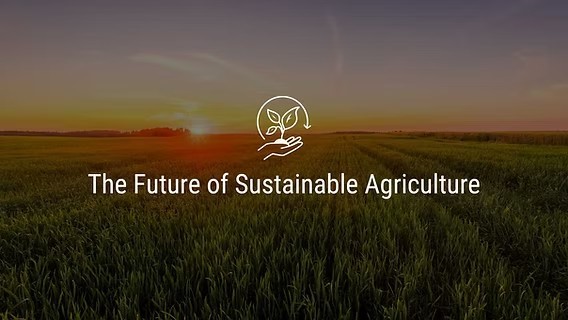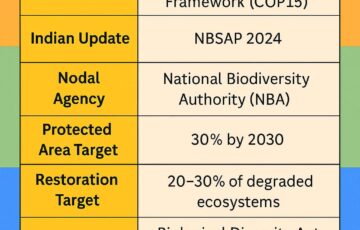Revolutionizing Agriculture for Sustainable Future and Clean Earth
Revolutionizing Agriculture for Sustainable Future and Clean Earth
Syllabus:
GS-1:
Agricultural Resources
GS-2:
Government Policies & Interventions
GS-3:
E-Technology in the Aid of FarmersCropping Patterns
Focus:
The editorial discusses the environmental challenges arising from unsustainable agricultural practices, pollution, and resource depletion in India. It emphasizes the urgent need for policy reforms, sustainable farming, and innovative solutions to restore the health of the planet and ensure a sustainable future for generations to come.
Earth’s Health Crisis and Need for Change:
International Mother Earth Day and Its Relevance
- International Mother Earth Day (April 22) was established by the UN General Assembly in 2009, aiming to promote sustainable development and harmony with nature.
- Earth is the only known planet capable of sustaining human life, highlighting the urgency to protect its resources, including air, water, soil, and biodiversity.
- Despite advancements, the environmental degradation continues, indicating that humanity has failed to protect the planet for future generations.
The Growing Population and Its Impact
- The world population has increased exponentially over the last century, from 1 billion in 1804 to 8 billion in 2025, creating unprecedented pressure on natural resources.
- India, being the most populous country, faces significant challenges due to this rapid population growth, particularly in terms of food production, energy use, and fossil fuel consumption.
- Fossil fuel dependency and intensive farming have resulted in global warming and air pollution, exacerbating the planet’s health crisis.
Sustainable Agriculture: Definition and BenefitsWhat is Sustainable Agriculture?● Sustainable agriculture refers to farming practices aimed at meeting current food and fiber needs while ensuring the long-term viability of agricultural systems and preserving natural resources for future generations. ● It focuses on three main pillars: environmental stewardship, economic profitability, and social equity. ● Key practices include: ○ Crop Switching ○ Organic Farming ○ Community Supporting Agriculture Benefits of Sustainable Agriculture● Environmental Conservation ○ Minimizes the impact on ecosystems, soil, water, and biodiversity. ○ Techniques like crop rotation, cover cropping, and agroforestry help in maintaining soil health and fertility. ○ Reduces soil erosion, water usage, and reliance on synthetic fertilizers and pesticides. ● Economic Viability ○ Aims to make agricultural practices economically feasible for farmers, ensuring fair income and sustainable livelihoods. ○ Enhances productivity, reduces production costs, and opens markets for sustainably produced goods. ● Social Equity ○ Fosters fair relationships among farmers, consumers, and stakeholders. ○ Ensures fair wages and working conditions for agricultural laborers. ○ Promotes access to healthy, nutritious food for all. ● Resilience to Climate Change ○ Builds systems resilient to climate variability and change. ○ Mitigates greenhouse gas emissions and supports climate resilience through adaptive practices. ● Biodiversity Preservation ○ Supports diverse ecosystems and genetic diversity in crops and livestock. ○ Ensures resilience against pests, diseases, and environmental changes by promoting indigenous crops and diverse landscapes. Recent Government Initiatives Related to Sustainable Agriculture: ● National Mission on Sustainable Agriculture (NMSA) ○ Focuses on promoting sustainable agriculture through improved soil health, efficient water use, and eco-friendly farming practices. ○ Aims to integrate climate-resilient practices in agriculture and improve farmers’ income. ● Paramparagat Krishi Vikas Yojana (PKVY) ○ Promotes organic farming by encouraging soil health management. ○ Provides financial support for organic certification, creating a sustainable value chain for organic produce. ● Sub-mission on Agroforestry (SMAF) ○ Encourages agroforestry by promoting the integration of trees with crops to enhance soil quality, water retention, and biodiversity. ○ Provides financial assistance for setting up agroforestry projects. ● Rashtriya Krishi Vikas Yojana (RKVY) ○ Aims to enhance agricultural productivity and ensure sustainable development through targeted interventions at the grassroots level. ○ Focuses on promoting innovative farming practices and resource-efficient technologies. ● Mission Organic Value Chain Development for North Eastern Region (MOVCDNER) ○ Aims to develop organic farming in the North Eastern states of India. ○ Focuses on creating value chains for organic produce and improving market access for farmers in the region. |
Environmental Degradation and Its Causes:
India’s Struggles with Pollution and Environmental Decline
- India ranks 176th in the Environmental Performance Index (EPI) 2024, indicating poor performance in terms of environmental health.
- The World Air Quality Report 2024 notes that 74 out of the 100 most polluted cities globally are in India, with Delhi-NCR residents losing an average of 119 years of life expectancy due to air pollution.
- The problem is especially acute in the Delhi-NCR region, where air pollution levels become catastrophic every winter, making the region akin to a “gas chamber”.
Depletion of Natural Resources
- While food production has increased to meet the growing demand, it has come at a high cost. Soil degradation, water depletion, and the loss of biodiversity are all consequences of unsustainable agricultural practices.
- Two-thirds of India’s soils have soil organic carbon levels below 0.5%, while ideally, it should be 1.5 to 2 percent.
- Groundwater in key agricultural regions like Punjab, Haryana, and Rajasthan is depleting at alarming rates, often exceeding 15 feet per year.
- Intensive farming practices, such as the rice-wheat crop rotation in Punjab and Haryana, have caused a reduction in biodiversity and long-term damage to the agricultural ecosystem.
Unsustainable Agricultural Practices: A Call for Reform:
Current Agricultural System and Its Unsustainability
- The Green Revolution helped save millions by increasing food production, but it also led to the overuse of chemical fertilizers, pesticides, and groundwater, which has caused irreparable environmental damage.
- India’s agricultural system is heavily reliant on chemical inputs, particularly urea and pesticides, and subsidies for these products have distorted market dynamics.
- Free power and subsidized fertilizers in regions like Punjab and Haryana have led to excessive use of these inputs, causing further damage to ecosystems.
The Need for a New Agricultural Approach
- Ecosystem services (PES) need to be incentivized to align farming practices with nature conservation.
- Carbon credits, water conservation, and promoting biodiversity should be integrated into the agricultural policies.
- The shift from unsustainable farming systems to more eco-friendly practices will require policy changes and innovative solutions that focus on sustainability.
Proposed Reforms for Sustainable Agriculture:
Repurposing Subsidies and Supporting Eco-Friendly Farming
- Subsidies should be restructured and directly transferred to farmers’ accounts, targeting sustainable practices.
- Deregulating the prices of power and fertilizers can help reduce environmental degradation and improve efficiency in resource allocation.
- Farmers should be encouraged to grow legumes like pulses and oilseeds, which are nitrogen-fixing, help conserve water, and support biodiversity.
- By promoting agro-ecological approaches, India can make its agricultural systems more resilient and sustainable in the long run.
Promotion of Renewable Energy in Farming
- The theme for Earth Day 2024 focuses on renewable energy, with an ambitious target of 300% increase by 2030.
- Agrivoltaics (solar power generation on agricultural land) should be encouraged as a third crop, allowing farmers to generate clean energy while enhancing their incomes.
- Discoms (power distribution companies) can purchase solar energy from farmers at a premium price (10-15% higher than thermal energy costs), which can contribute to the green revolution in India’s agriculture.
Achieving a Sustainable Future:
India’s Role in Global Environmental Protection
- India must focus on transitioning to a cleaner, sustainable agricultural system, aligning economic growth with environmental preservation.
- Reforming agricultural policies to support eco-friendly practices, and renewable energy integration will not only protect the environment but also enhance the livelihood of farmers.
- A revolution of clean energy in India’s agriculture can significantly contribute to the nation’s energy security, while simultaneously protecting Mother Earth.
The Path to a Greener Future
- India must balance its agricultural growth with environmental conservation by ensuring that sustainability becomes a core principle of farming practices.
- Sustainable farming practices, coupled with the promotion of renewable energy and eco-friendly agricultural policies, will lead to a healthier planet and a more prosperous future for the next generation.
Key Challenges and Way Forward:
Challenges
- Resistance to change from traditional farming communities.
- Financial constraints and lack of infrastructure to support sustainable practices.
- Political and policy challenges in implementing long-term agricultural reforms.
Way Forward
- Establish clear and innovative policies to encourage sustainable farming and eco-friendly practices.
- Integrate renewable energy solutions into the agricultural system to promote clean energy while boosting farmers’ incomes.
- Encourage global cooperation for sustainable agriculture to combat climate change and environmental degradation.
Conclusion:
Immediate and transformative actions are needed to shift towards sustainable agricultural practices, reduce pollution, and conserve essential resources like soil, water, and biodiversity. Policy reforms, incentivizing eco-friendly farming, and promoting renewable energy on farms can foster a cleaner, more sustainable future for both agriculture and the planet.
Source: IE
Mains Practice Question:
How can India transition to sustainable agricultural practices while ensuring food security and environmental conservation? Discuss the key policy measures and technological innovations needed to achieve this balance.





